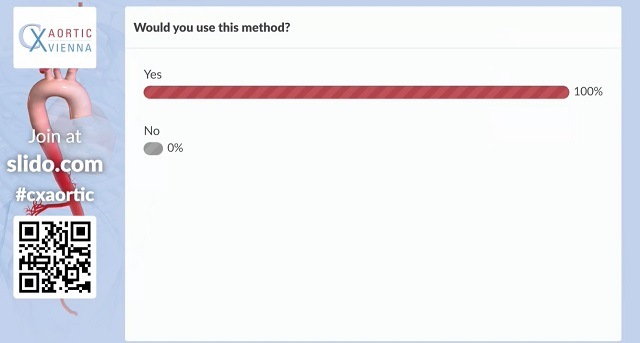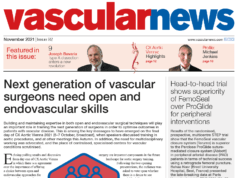
Thought-provoking presentations, debate and polling during the first day of CX Aortic Vienna 2021 (5–7 October, broadcast) have shed light on important considerations for the treatment of juxtarenal aortic neck challenges.
During the session, participants unanimously backed use of the enhanced proximal seal endosuture aneurysm repair (ESAR) technique for the treatment of wide neck abdominal aortic aneurysms (AAAs), and a later poll found support for chimney endovascular aortic aneurysm repair (CHEVAR) in certain cases. A presentation on accessory renal artery management also prompted panellists to question if attitudes towards covering or preserving these vessels should be reappraised.
All sessions are available to view on demand. Click here to register and access the recordings.
Presenting an edited case of ESAR, Giovanni Pratesi (Genoa, Italy) documented the treatment of a 77-year-old male admitted to his centre for asymptomatic AAA. The approach deployed by Pratesi and his team used a stent graft combined with the ESAR technique using the Heli-Fx endoanchor system (Medtronic), applied to increase the durability and effectiveness of the endovascular repair, according to Pratesi.
Pratesi documented that the technique achieved complete exclusion of the AAA while preserving the renal arteries without compromising the sealing of the iliac limb. Following the presentation, audience members were polled on whether they would use this method, with 100% of those responding voting that ‘yes’ they would.
 Registrants can view Pratesi’s edited case on demand here.
Registrants can view Pratesi’s edited case on demand here.
Further polling followed the presentation of Konstantinos Donas (Münster, Germany) who answered the question ‘is CHEVAR ever indicated?’. During his presentation, Donas highlighted a “striking” message to have emerged from the CX 2021 Digital Edition (19–22 April, online), in which panellists agreed that parallel grafts should be used ‘as little as possible’ in the hostile neck anatomy.
“Based on this the answer is very easy, CHEVAR is never indicated,” Donas said. However, he added that the clinical reality is different, highlighting application of CHEVAR in treatment of “demanding” anatomies, including those with severe angulation of the neck, severe calcification, or stenosis of the iliac access.
But, Donas conceded that CHEVAR is not indicated as the first therapeutic choice in cases with multiple chimneys and where there is a high risk of suboptimal performance in cases of poor oversizing, use of self-expandable covered stents, and where there is presence of a short new sealing zone.
 Registrants can view Donas’ presentation on demand here.
Registrants can view Donas’ presentation on demand here.
Commenting following the presentation by Donas, moderator Tilo Kölbel (Hamburg, Germany) commented that this was a “strong message” to have emerged from the talk, and he pressed Donas on the alternatives for CHEVAR in urgent juxtarenal cases.
“There is no doubt that as vascular surgeons, we are speaking all the time about endo[vascular] repair,” answered Donas. “But, we have in mind, especially in suboptimal anatomical conditions for endo repair, the open approach depending on the general conditions of the patients.”
Referring to Pratesi’s earlier presentation, Donas added: “There is no doubt that ESAR is an alternative option in the case of having an infrarenal neck in order to avoid spending time for the cannulation in the renal [arteries] and to improve durability. I would say these are the alternatives.”
Donas also stressed that in his view, ESAR is important for improving fixation of the device, while CHEVAR is aimed at achieving a sealing zone in the healthy segment of the aorta.
Audience polling, which took place subsequently found that 73% of respondents agree that CHEVAR is sometimes indicated, while 27% voted that it is not.
Later presentations included details of endovascular treatments of visceral aneurysm patch (VAP) after previous thoracoabdominal aortic aneurysm (TAAA), which were outlined in a talk delivered by Luca Bertoglio (Milan, Italy). Bertoglio told CX Aortic Vienna attendees that the endovascular solution for VAP is technically feasible, but noted it is complex and challenging.
Registrants can view Bertoglio’s presentation on demand here.
Renal arteries: To cover or preserve?
Jose Ignacio Torrealba (Santiago, Chile) then discussed accessory renal arteries in complex aortic repair, arguing that revascularisation may improve renal function results. Torrealba told CX attendees that when sealing is compromised, accessory renal artery management comes into question, and said that there is currently conflicting evidence for accessory renal artery preservation. However, his presentation concluded that in cases of complex aortic repair, accessory renal artery preservation is feasible, safe and associated with better outcomes with the use of custom-made devices.
Registrants can view Torrealba’s presentation on demand here.
In the discussion following his presentation, Torrealba was pressed by Kölbel and the session anchor Roger Greenhalgh (London, UK) on whether more notice of the accessory renal arteries is justified. “Are we not 100% sure that an accessory renal artery should be covered and not preserved?” Greenhalgh probed. To this question, Torrealba responded, “this is what I want to show”.
Kölbel then followed up this statement by offering his own view, adding: “I believe we will see what we have seen in iliac branch devices. We will change from an attitude that ‘we can cover this, it does not justify the effort to preserve’ to an attitude today that we preserve whatever is possible.”












